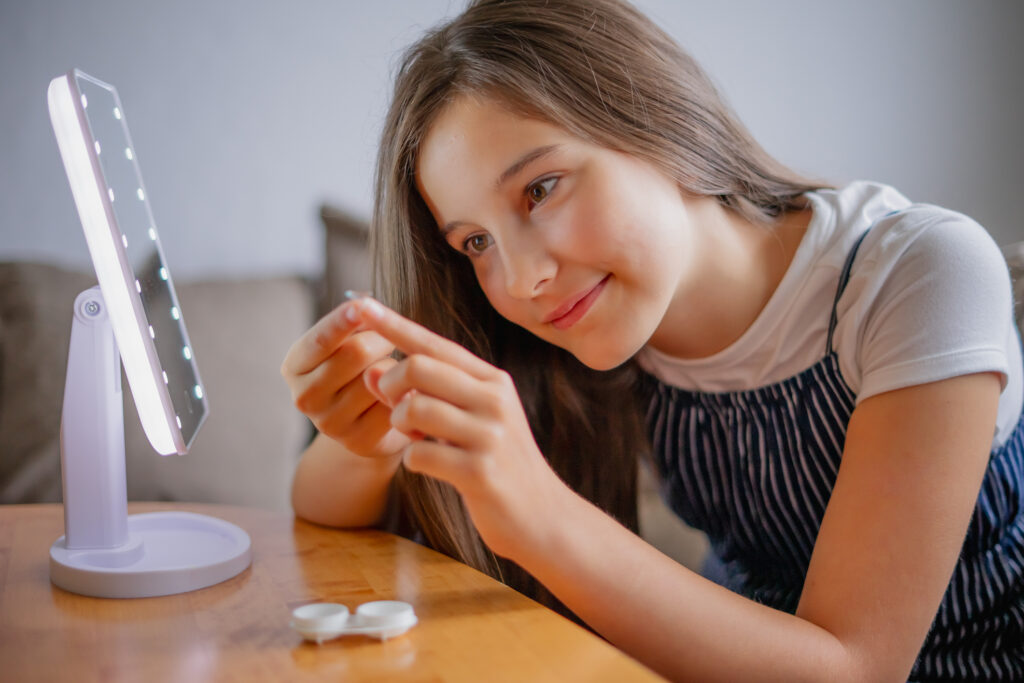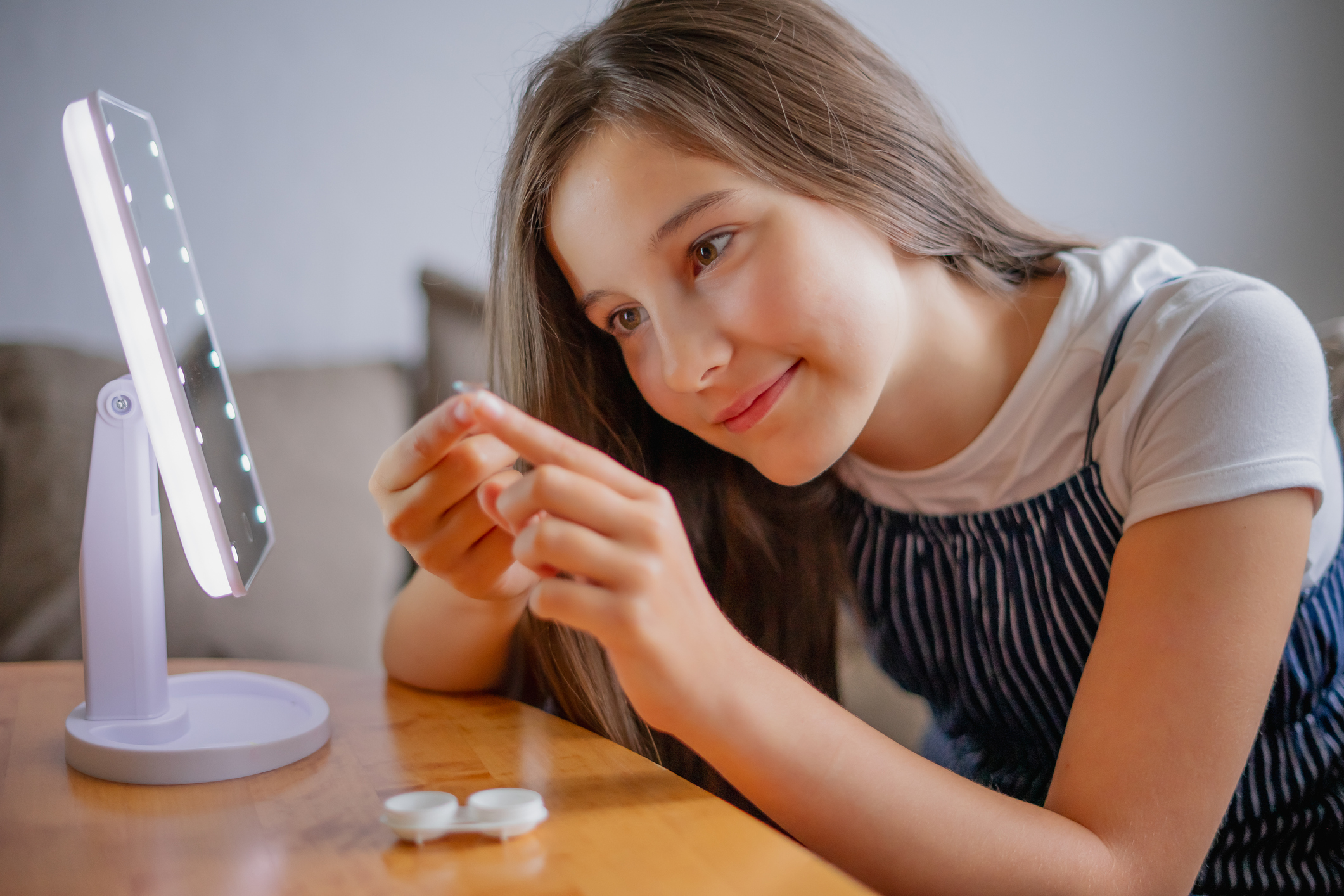
Myopia is a condition which causes blurred vision for far away objects, and in high levels can even cause blurred vision beyond arm’s length. Also known as short-sightedness or nearsightedness, myopia is a growing concern for Canadian children, with more and more children affected nowadays due to genetic and environmental factors. If left untreated, myopia progressively worsens and this can lead to high myopia, increasing the risk of sight-threatening eye diseases such as retinal detachment, glaucoma, and myopic maculopathy which can occur in adulthood. Fortunately, new advances in myopia management offer options to slow myopia progression and reduce the risks of myopia, beyond traditional single-vision glasses. One of the most effective options available today are soft contact lenses designed for myopia control.
What Are Myopia Control Soft Contact Lenses?
Soft contact lenses offer an alternative to spectacles for vision correction and are made from flexible, breathable materials that sit on the front surface of the eye. Unlike standard single-vision contact lenses, which only correct blurred vision, myopia control soft contact lenses are designed to give children clear vision as well as slow the progression of myopia in children.
These lenses use optical designs that alter how light focuses on the retina, the light sensitive layer at the back of the eye, helping to reduce the eye’s tendency to grow too quickly, as it does in myopia. Myopia control contact lenses incorporate multiple focal powers within the lens, which research has shown is effective in slowing down myopia progression in children.1
How Do Myopia Control Soft Contact Lenses Work?
Myopia control soft contact lenses function by changing how light enters the eye and focuses on the retina. Standard single-vision contact lenses focus light directly onto the central retina but allow peripheral light rays to focus behind it, which can contribute to increased eye elongation and worsening myopia. In contrast, myopia control lenses use specialized optical designs to manipulate peripheral focus and reduce the stimulus for excessive eye growth.2
The two main optical strategies used in myopia control soft contact lenses include:
- Dual-focus lenses: These lenses contain alternating treatment and correction zones. The treatment zones introduce peripheral myopic defocus, which means that light rays are focused in front of the peripheral retina, signalling the eye to slow its growth. MiSight® 1 day, one of the most well-researched myopia control lenses, uses this design.2
- Multifocal lenses with concentric rings: These lenses incorporate multiple zones of different optical powers to manage both distance vision and myopia control. The Acuvue® Abiliti™ 1-Day lens follows this design, offering clear central vision while creating a myopia control effect through its ring-focus zones.3
Health Canada-Approved Myopia Control Soft Contact Lenses
Here in Canada, three soft contact lenses have received Health Canada approval for myopia control in children: MiSight® 1 day, Naturalvue® Multifocal 1 Day and Acuvue® Abiliti™ 1-Day. These lenses have been developed to manage myopia and are scientifically proven to slow myopia progression, making them the evidence-based soft contact lens options for myopia management.
- MiSight® 1 day (CooperVision): This dual-focus daily disposable lens has been studied in a six-year clinical trial, demonstrating a 59% reduction in myopia progression and a 52% reduction in axial elongation. Its optical design features alternating treatment and correction zones, ensuring clear vision while actively slowing eye growth.2
- Acuvue® Abiliti™ 1-Day (Johnson & Johnson Vision): This daily disposable multifocal lens with concentric ring technology has been studied in a 6-month clinical trial, showing its effectiveness in slowing myopia progression in children aged 7 to 12 years. Its optical design balances myopia control with clear vision for everyday activities.3
- NaturalVue® Multifocal 1 Day (Visioneering Technologies, Inc): This contact lens is also daily disposable and uses an extended depth of focus (EDOF) design, which creates a smooth transition of power across the lens, helping to manage eye growth in myopia. It has been studied in children as young as 5 years old and up to 20 years old, with a primary focus on children around 8 to 13 years old. So far studies on these lenses have looked back at past patient records rather than following children in a planned study from the start. This means the results are based on real-world use, but more research is needed to confirm how well the lenses work over time. A gold-standard clinical trial is now underway, with early results showing high effectiveness which is likely similar to other soft contact lens designs.4
These lenses have undergone rigorous clinical testing to confirm their safety and effectiveness. MiSight® 1 day is approved for children aged 8 to 12 years at the start of treatment, while Acuvue® Abiliti™ 1-Day is approved for children aged 7 to 12 years, and NaturalVue® Multifocal 1 Day in children aged 8 to 13 years. Research confirms that children wearing these lenses experience significantly slower worsening of their myopia compared to those using traditional single-vision correction.
You can read more about myopia control soft contact lenses and the levels of evidence for each design in the article How do myopia control soft contact lenses work? on MyKidsVision.org.
Benefits of Soft Contact Lenses for Myopia Control
- Slowing Myopia Progression: These lenses can significantly reduce the rate at which myopia worsens, giving kids more stable vision between their eye exams, and reducing the risk of the development of high myopia. By slowing axial elongation, they help lower the risk of future eye health complications such as retinal detachment, glaucoma, and myopic maculopathy.2,3
- Improved Quality of Life: Wearing contact lenses instead of glasses can enhance a child’s confidence and self-esteem, as studies show that children feel more comfortable with their appearance while wearing contact lenses. Additionally, children report greater ease in participating in sports and other physical activities due to the unrestricted field of vision that contact lenses provide.5,6
- Consistent Vision Correction: Unlike glasses, which can slip, break, or become misaligned, soft contact lenses stay in place throughout the day. This ensures that children receive consistent vision correction, which is important for schoolwork, outdoor activities, and digital device use. It is especially important for myopia control treatments, where full time wear of these specialized contact lenses is recommended for the best possible outcomes.
- Safe for Children: Research indicates that children as young as 7 years old can safely wear soft contact lenses when following proper hygiene and care guidelines. Daily disposable (single use) lenses, which are disposed of at the end of each day with a fresh pair commenced the next day (such as those described here), significantly reduce the risk of eye infections and discomfort issues, making them an excellent choice for kids and teens.7
- Better Peripheral Vision: Contact lenses provide a wider and more natural field of view compared to glasses, where the frame can get in the way of peripheral vision. This can be particularly beneficial for children who are active in sports or other activities that require good peripheral vision and awareness.
- Adaptability and Comfort: Soft contact lenses are designed with advanced materials that enhance breathability and ensure long-lasting comfort. Most children adapt very quickly to wearing contact lenses and find them more convenient than glasses.
Choosing the Right Myopia Control Option for Your Child
While soft contact lenses are a highly effective option to give your child great vision as well as slow their myopia progression, they are not the only option available. Special types of spectacle lenses (glasses), orthokeratology (Ortho-K) contact lenses, and atropine eye drops are also available. No single treatment has been proven superior to all others, so the best choice depends on factors that your child’s Optometrist can discuss with you, including:
- Availability in Canada
- Your child’s prescription and eye health
- Your family’s lifestyle and preferences
- Likelihood of compliance with lens wear and care routines
To read more about choosing the right option for myopia control, you can look at the article Which is the best option for myopia control? on MyKidsVision.org.
What you can do next
Soft contact lenses for myopia management represent a major advancement in vision care for Canadian children. With proven effectiveness in slowing myopia progression, they offer a safe and convenient alternative to glasses for kids and teens. Ask your child’s Optometrist about whether myopia control contact lenses are a good option, to give your child healthy vision now and into the future.
References:
- Chen M, Shu Q, Li F, Li L, Fan X. The whole life cycle myopia management. Asia Pac J Ophthalmol (Phila). 2025 Jan 26:100161.
- Chamberlain P, Hammond DS, Arumugam B, Bradley A. Six-year cumulative treatment effect and treatment efficacy of a dual focus myopia control contact lens. Ophthalmic Physiol Opt. 2024 Jan;44(1):199-205.
- Cheng X, Xu J, Brennan NA. Randomized Trial of Soft Contact Lenses with Novel Ring Focus for Controlling Myopia Progression. Ophthalmol Sci. 2022 Oct 18;3(1):100232.
- Tuan KMA. A Randomized Controlled Trial for Myopia Progression Control Using Catenary Power Profile Contact Lenses: 12-month Effectiveness and Safety. Invest Ophthalmol Vis Sci. 2024:ARVO Abstract 2697.
- Lumb E, Sulley A, Logan NS, Jones D, Chamberlain P. Six years of wearer experience in children participating in a myopia control study of MiSight® 1 day. Cont Lens Anterior Eye. 2023 Aug;46(4):101849.
- Dias L, Manny RE, Weissberg E, Fern KD. Myopia, contact lens use and self-esteem. Ophthalmic Physiol Opt. 2013 Sep;33(5):573-80.
- Bullimore MA. The Safety of Soft Contact Lenses in Children. Optom Vis Sci. 2017 Jun;94(6):638-646.



